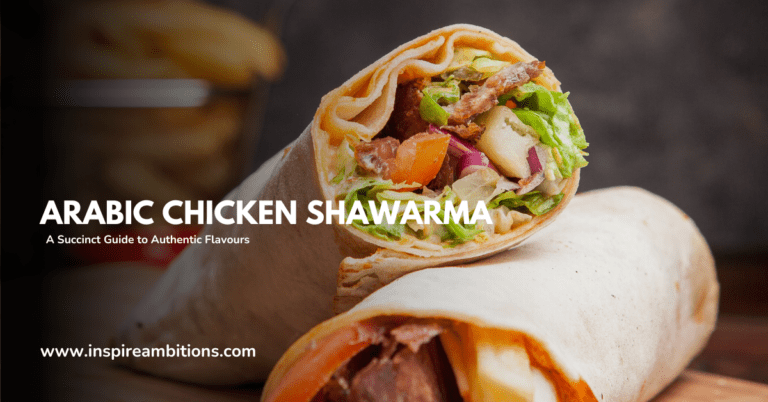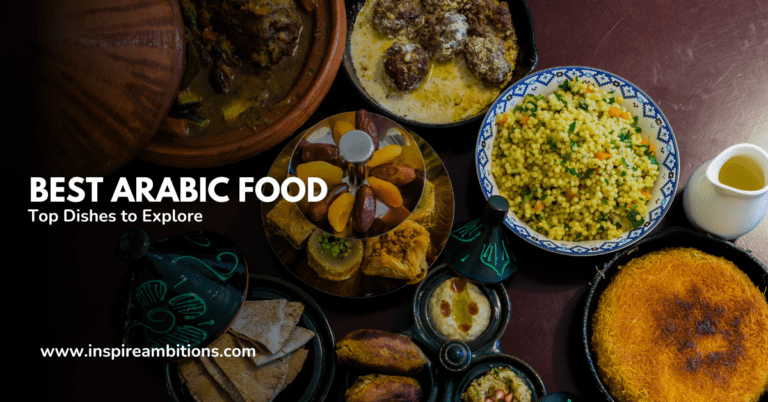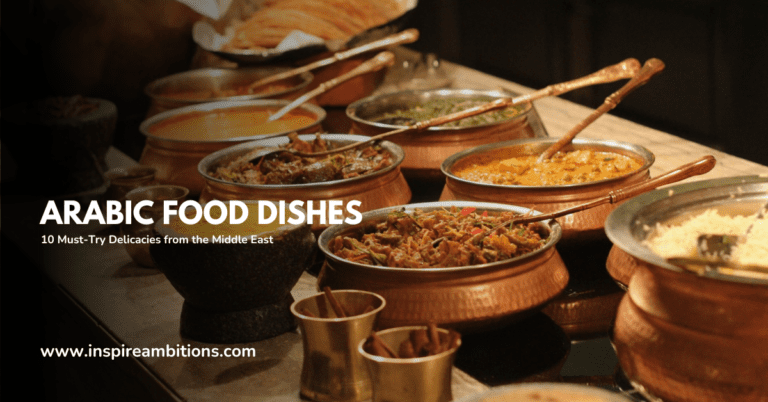আরবি অ্যাপেটাইজার - মধ্যপ্রাচ্যের স্টার্টারদের টানটালাইজ করার জন্য একটি গাইড
Arabic appetizers, known as meze, are a delicious and vibrant way to start your culinary journey through Middle Eastern cuisine. These small dishes, meant for sharing, offer a diverse range of flavours and textures to stimulate your palate.
From creamy hummus and smoky baba ganoush to spicy potato dishes such as Batata Harra, the world of Arabic appetizers provides ample opportunity to explore new tastes and combinations.
As you delve into the world of meze, you’ll encounter aromatic spices like Baharat – a blend of nutmeg, cardamom, coriander, paprika, black pepper, cinnamon, cumin, and cloves – that create a unique flavour profile in many Arabic dishes.
Additionally, various herbs and vegetables, such as coriander and zucchini, add freshness and depth to the flavours.
To get the most out of your Arabic appetizer experience, enjoy them alongside a warm, freshly baked flatbread, perfect for scooping up the enticing dips and spreads.
By experimenting with these appetizers, you’ll gain a richer appreciation for the culinary traditions of the Middle East, and embark on a gastronomic adventure that is sure to delight your taste buds.
Historical Background of Arabic Appetizers
এর অন্বেষণ করা যাক.
Development Over Time
Arabic appetizers have a rich history dating back to the 7th century when Arabs from the Arabian Peninsula arrived at the eastern Mediterranean and later migrated to occupy North Africa. During this time, they were introduced to a variety of foods.
In ancient Greece and Rome, people often socialised while enjoying small bites of fruit, cured meat, cheese, fish, and olives. Over the years, the tradition of serving appetizers evolved, with the French term for appetizers, hors d’oeuvre, translating to “outside of the masterpiece.”
Today, Arabic appetizers have become an essential part of Middle Eastern cuisine, with various dips like hummus and moutabel taking centre stage.
Other popular appetizers include Baharat, a spice mix frequently used in Middle Eastern and Arabian Peninsula dishes, and Ras el Hanout, another spice blend originating from North Africa.
Regional Differences
Arabic appetizers vary depending on the region. In Lebanon, hummus kawarma is a popular choice, made by topping freshly made hummus with fried pieces of lamb.
On the other hand, muhammara, a spicy red pepper dip, is often served as an appetizer in the Levantine region. Different regions also have their unique takes on spice combinations, such as Baharat and Ras el Hanout.
- Hummus Kawarma: popular in Lebanon, topped with fried lamb
- Muhammara: served in the Levantine region as a spicy red pepper dip
- Baharat: a widely used spice mix in the Middle East and Arabian Peninsula
- Ras el Hanout: originating from North Africa, another popular spice blend
With these regional differences, you can explore a diverse range of Arabic appetizers depending on the area of Middle Eastern cuisine you choose to indulge in, immersing yourself in the culinary history and culture while satisfying your appetite.
Popular Arabic Appetizers
ফালাফেল
Falafel is a well-loved dish in Arabic cuisine, often enjoyed as an appetiser, platter, or in a sandwich. These deep-fried balls or patties are primarily made from ground chickpeas, fava beans, or a combination of both. Crispy on the outside and soft on the inside, Falafel is a must-try for anyone exploring Arabic flavours.
তাব্বুলেহ
Tabbouleh is a refreshing and colourful salad that makes for a fantastic appetiser. The main ingredients include finely chopped parsley, tomatoes, onions, and bulgur, which are all mixed with a zesty dressing made of lemon juice, olive oil, and various seasonings.
This salad is not only flavourful but also healthy, and it pairs well with many other Arabic dishes.
বাবা ঘানুশ
Baba Ghanoush is a delicious, creamy dip made primarily of roasted aubergines (eggplants), tahini, garlic, and lemon juice. This appetiser is typically served with warm pita bread or fresh-cut vegetables for dipping.
With its smoky and savoury taste, baba ghanoush is a delightful accompaniment for various Arabic meals.
ফতুশ
Fattoush is another popular Arabic salad, which consists of mixed greens, tomatoes, cucumbers, and radishes. What sets this dish apart is the addition of crispy pita bread pieces, which add a wonderful texture to the salad.
The dressing for fattoush is typically made from olive oil, lemon juice, and pomegranate molasses, giving it a sweet and tangy flavour that complements the fresh ingredients.
প্রস্তুতির কৌশল
রান্নার পদ্ধতি
When preparing Arabic appetizers, you’ll find a variety of cooking methods that enhance the flavours of the dishes. Some common techniques include:
- গ্রিলিং: This method involves cooking food over direct heat, typically on a gas or charcoal grill. You can use this technique for preparing vegetables, such as peppers for a traditional muhammara dip, and meats like kofta skewers or grilled halloumi cheese.
- Roasting: Roasting vegetables like eggplant and zucchini in the oven at a high temperature brings out their natural sweetness and adds depth to dishes like baba ganoush and fattoush.
- Frying: Shallow or deep frying is often used to prepare crispy favourites such as Falafel and Sambousek. Be sure to use a high-quality oil with a high smoke point, like olive oil or sunflower oil, for optimal results.
Selection of Ingredients
Understanding the core ingredients used in Arabic appetizers will help you recreate these delicious dishes at home:
- Spices and herbs: Seasoning is key to achieving authentic flavours in Arabic appetizers. Common spices include cumin, sumac, and za’atar, while fresh herbs like parsley and mint add brightness to many dishes.
- Dips and sauces: Creamy or tangy dips and sauces play a central role in Arabic appetizer recipes. Examples include hummus, tahini, and garlic sauce (toum), which are typically served alongside grilled meats and vegetables or with warm pita bread.
- Fresh produce: A variety of vegetables and fruits are used in Arabic appetizers. Some popular choices are tomatoes, cucumbers, eggplant, zucchini, and olives. These ingredients can be sliced, roasted, grilled, or incorporated into salads or dips.
- Grains and legumes: Rice, bulgur, and chickpeas are common ingredients used in Arabic appetizers. They add texture and substance to dishes like tabbouleh, stuffed vine leaves (dolma), and mujadara.
By experimenting with these cooking methods and ingredient selections, you’ll be able to create a variety of delicious and authentic Arabic appetizers to enjoy at home.
Serving and Presentation
Serving Traditions
When it comes to serving Arabic appetizers, you’ll notice a few common traditions. Firstly, mezze is a key concept in মধ্যপ্রাচ্যের খাবার, referring to a spread of small dishes served before the main meal.
Traditional Arabic appetisers like hummus, labneh, and motabal are often presented together as part of a mezze platter, accompanied by warm flatbreads like pita or khubz.
In many Middle Eastern cultures, the act of sharing food is essential, often symbolising আতিথেয়তা and unity.
As such, you’ll find that Arabic appetizers are usually served in communal dishes, allowing guests to dip bread or scoop up their desired portions.
It’s also important to consider the order in which you serve your appetizers. Cold dishes such as salads and dips are commonly presented first, followed by warm dishes like kibbeh or falafel.
When hosting your own Arabic-inspired event, try replicating this traditional sequencing to create an authentic experience.
Photogenic Display
The presentation of food plays a crucial role in Arabic cuisine and visually appealing appetisers can complement the delicious flavours. Here are some tips for creating a photogenic display of your Arabic appetizers:
- Colourful garnishes: Elevate the appearance of your dishes by adding vibrant garnishes like chopped herbs, pomegranate seeds, or edible flower petals. A sprinkle of sumac or za’atar can also contribute to an appealing visual contrast.
- Plating with purpose: Arrange your appetisers on a large platter with intention, using different shapes and sizes of dishes to create a visually interesting spread. For instance, you might place a round bowl of hummus in the centre, surrounded by triangles of kibbeh and colourful salads.
- Layering textures: To captivate the eye and entice your guests, incorporate various textures in your presentation. For example, crunchy Falafel balls placed atop a smooth and creamy bed of hummus can create an appealing contrast in textures.
- Use traditional tableware: Enhance the authenticity of your Arabic appetizer display by using traditional tableware like ceramic or brass plates, giving your dishes an additional element of Middle Eastern charm.
Remember, the goal is to create an inviting and visually appealing spread that showcases the delectable flavours of Arabic cuisine. By focusing on these presentation tips, you can ensure your appetisers look just as impressive as they taste.
পুষ্টির মান
স্বাস্থ্য সুবিধাসমুহ
Arabic appetizers not only offer diverse flavours but also provide various health benefits. For instance, hummus, a popular dish made from chickpeas, contains a good amount of protein and fibre, which can help you feel full and satisfied.
This dish also contains healthy fats, vitamins, and minerals.
Another appetiser, labneh or Lebanese cream cheese, is made from strained yoghurt and provides a great source of calcium and protein. The probiotics found in this dish promote good gut health.
Batata Harra, a spicy Lebanese vegetable dish, is made from potatoes fried with garlic, chilli, and coriander. Potatoes provide a substantial amount of vitamins, minerals, and fibre, while the spices used in this dish are known to have anti-inflammatory and antioxidant properties.
Dietary Restrictions
Arabic appetisers can cater to various dietary restrictions. For example, কিবেহ ইহা একটি Middle Eastern dish made from meat and bulgur wheat. It can be made with different types of meat, adapting to your dietary needs or preferences.
For those following a vegetarian or vegan diet, many Arabic appetisers such as hummus and zucchini baba ganoush are plant-based.
Alternatively, you could try making ফালাফেল, a delectable dish made from ground chickpeas, onions, and a variety of spices.
It is important to note that some Arabic appetisers contain ingredients that may not be suitable for individuals with certain allergies or intolerances, such as gluten in bulgur wheat, dairy in labneh, or sesame in tahini.
In these cases, simply look for alternative ingredients or recipes that cater to your specific dietary requirements.
Remember, Arabic appetisers offer delicious and nutritious options for various dietary needs. By understanding the ingredients and health benefits, you can enjoy these dishes while also supporting your health and dietary choices.






